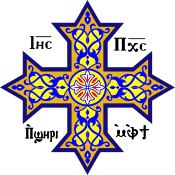
Vespers is a liturgy of evening prayer, one of the canonical hours in Catholic, Eastern Orthodox, Oriental Orthodox, and Lutheran liturgies. The word for this prayer time comes from the Latin vesper, meaning "evening".
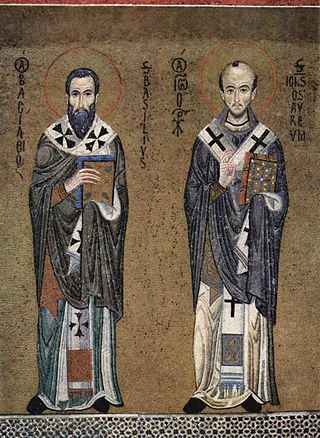
Divine Liturgy or Holy Liturgy is the usual name used in most Eastern Christian rites for the Eucharistic service.

The Sanctus is a hymn in Christian liturgy. It may also be called the epinikios hymnos when referring to the Greek rendition and parts of it are sometimes called "Benedictus". Tersanctus is another, rarer name for the Sanctus. The same name is sometimes used for the Trisagion.
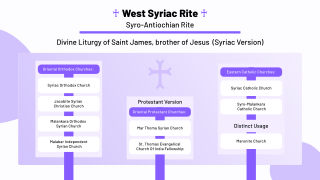
The Liturgy of Saint James is a form of Christian liturgy used by some Eastern Christians of the Byzantine rite and West Syriac Rite. It is developed from an ancient Egyptian form of the Basilean anaphoric family, and is influenced by the traditions of the rite of the Church of Jerusalem, as the Mystagogic Catecheses of Cyril of Jerusalem imply. It became widespread in Church of Antioch from the fourth or fifth century onwards, replacing the older Basilean Liturgy of Antioch. It is still the principal liturgy of the Syriac Orthodox Church, the Malankara Orthodox Syrian Church, the Maronite Church, the Syriac Catholic Church, Syro-Malankara Catholic Church and other churches employing the West Syriac Rite. It is also occasionally used in the Eastern Orthodox Church and Melkite Catholic Church. The Malankara Mar Thoma Syrian Church uses a reformed variant of this liturgy, omitting intercession of saints and prayer for the dead.

Beneath Thy Protection is an ancient Christian hymn and prayer. It is one of the oldest known Marian prayers and among the most ancient preserved hymns to the Blessed Virgin Mary that is still in use. Papyrus 470, containing a substantial portion of the prayer, was dated initially to the 3rd or 4th century; however later scholars proposed much later datings, even as far as the 9th century. The dating of the Papyrus remains uncertain. The hymn is well attested among the believers of the Catholic Church, the Eastern Orthodox Church and Oriental Orthodoxy.

The Alexandrian rites are a collection of ritual families and uses of Christian liturgy employed by three Oriental Orthodox churches, and by three Eastern Catholic Churches.
The Liturgy of Saint Basil or, more formally, the Divine Liturgy of Saint Basil the Great, is a term for several Eastern Christian celebrations of the Divine Liturgy (Eucharist), or at least several anaphoras, which are named after Basil of Caesarea. Two of these liturgies are in common use today: the one used in the Byzantine Rite ten times a year, and the one ordinarily used by the Coptic Church.
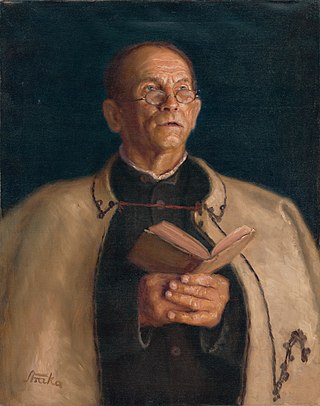
In Christianity, the cantor, female chantress, sometimes called the precentor or the protopsaltes, is the chief singer, and usually instructor, employed at a church, with responsibilities for the choir and the preparation of the Mass or worship service. The term is also used for a similar task in Reform Judaism and in Ancient Egypt.
The Institute of Coptic Studies was founded in 1954 by the Coptic Orthodox Church of Alexandria. It is based in Cairo.
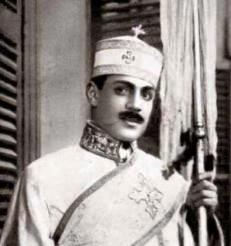
Archdeacon Habib Qozman Mankarious Girgis or simply Saint Habib Girgis, was a modern-day dean of the Catechetical School of Alexandria.

A liturgical book, or service book, is a book published by the authority of a church body that contains the text and directions for the liturgy of its official religious services.
Only-Begotten Son, sometimes called "Justinian's Hymn", the "Anthem of Orthodoxy" and/or the "Hymn of the Incarnation", is an ancient Christian hymn that was composed prior to the middle of the 6th century. It is chanted at the end of the Second Antiphon during the Divine Liturgies of St John Chrysostom, St Basil the Great and of St Gregory the Illuminator, and at the Little Entrance during the Liturgy of Saint James.

George Ernest Newlandsmith, was a British musicologist with strong Christian belief who formed the Laresol Society to promote artistic vocation of a religious nature. Together with Dr. Ragheb Muftah he was instrumental in noting down and audio recording traditional Coptic church music in the years 1927 to 1936.
Dr. Ragheb Moftah (1898–2001) was an Egyptian musicologist and scholar of the Coptic music heritage. He co-authored the article on "Coptic Music" for the Coptic Encyclopedia. He spent much of his life studying the recording and notation of Coptic liturgical texts. The son of Habashi Moftah and Labiba Shalaby, Moftah was one of nine children.
Mikhail Girgis El Batanouny was an Egyptian expert in Coptic music, and knowledgeable in church rites, in addition to being skilled in the languages of Coptic and Arabic.

The Coptic Rite is an Alexandrian liturgical rite. It is practiced in the Coptic Orthodox Church and the Coptic Catholic Church.
"Salam Affandina" was the national anthem of Egypt from 1871 to 1922 and 1936–1958, then it was replaced by "Walla Zaman Ya Selahy". It was renamed "Egyptian Republican Anthem" in 1953 after the Egyptian revolution of 1952. It was instrumental and had no official lyrics.

Ethiopian liturgical chant, or Zema, is a form of Christian liturgical chant practiced by the Ethiopian Orthodox Tewahedo Church. The related musical notation is known as melekket. The tradition began after the sixth century and is traditionally identified with Saint Yared. Through history, the Ethiopian liturgical chants have undergone an evolution similar to that of European liturgical chants.

Orthodox Tewahedo music refers to sacred music of the Ethiopian and Eritrean Orthodox Tewahedo Church. The music was long associated with Zema (chant), developed by the six century composer Yared. It is essential part of liturgical service in the Church and classified into fourteen anaphoras, with the normal use being the Twelve Apostles.
